Assessing the Impacts of Urban Expansion on Bundles of Ecosystem Services by Dmsp-Ols Nighttime Light Data
Abstract
:1. Introduction
2. Materials and Methods
2.1. Study Area
2.2. Overview of the Method
2.3. Quantification of Urban Expansion Level by Nighttime Light Data
2.3.1. Radiation Correction of Nighttime Light Data
2.3.2. Continuity Correction of Nighttime Light Data
2.3.3. Correction Results of Nighttime Light Data
2.3.4. Urban Expansion Level by Nighttime Light Data
2.4. Quantification of ESs
3. Results
3.1. Urban Expansion Level Model Verification and Analysis
3.1.1. Urban Expansion Level Model Verification
3.1.2. Urban Expansion Level Analysis
3.2. Impact of Urban Expansion Level Changes on Ecosystem Services
3.2.1. Changes to Ecosystem Services in Different Urban Expansion Level Zones
3.2.2. The Impact of Urban Expansion Level on Ecosystem Services
3.3. Impact of Changes in Urban Expansion Level on Bundles of Ecosystem Services
3.3.1. Trade-Offs and Synergies Among the Ecosystem Services
3.3.2. The Impact of Urban Expansion Level on Bundles of Ecosystem Services
4. Discussion
4.1. Comparative Analysis of Different Human Activity Model
4.2. Impacts of Urban Expansion on Ecosystem Services
4.3. Ecosystem Services Bundles and Urban Expansion Level
5. Conclusions and Policy Implications
Author Contributions
Funding
Acknowledgments
Conflicts of Interest
References
- MEA (Millennium Ecosystem Assessment). Ecosystems and Human Well-Being: Synthesis, 2nd ed.; Island Press: Washington, DC, USA, 2005. [Google Scholar]
- Kumar, P. The Economics of Ecosystems and Biodiversity: Ecological and Economic Foundations; Earthscan: Washington, DC, USA, 2010; pp. 34–35. [Google Scholar]
- Costanza, R.; de Groot, R.; Sutton, P.; van der Ploeg, S.; Anderson, S.J.; Kubiszewski, I.; Farber, S.; Turner, R.K. Changes in the global value of ecosystem services. Glob. Environ. Chang. 2014, 26, 152–158. [Google Scholar] [CrossRef]
- Sun, X.; Li, F. Spatiotemporal assessment and trade-offs of multiple ecosystem services based on land use changes in Zengcheng, China. Sci. Total Environ. 2017, 609, 1569–1581. [Google Scholar] [CrossRef] [PubMed]
- Li, B.J.; Chen, D.X.; Wu, S.H.; Zhou, S.L.; Wang, T.; Chen, H.S. Spatio-temporal assessment of urbanization impacts on ecosystem services: Case study of Nanjing City, China. Ecol. Indict. 2016, 71, 416–427. [Google Scholar] [CrossRef]
- Terfa, K.B.; Chen, N.C.; Liu, D.D.; Zhang, X.; Niyogi, D. Urban Expansion in Ethiopia from 1987 to 2017: Characteristics, Spatial Patterns, and Driving Forces. Sustainability 2019, 11, 2973. [Google Scholar] [CrossRef]
- Weng, Q.H. Remote sensing of impervious surfaces in the urban areas: Requirements, methods, and trends. Remote Sens. Environ. 2012, 117, 34–49. [Google Scholar] [CrossRef]
- Hu, T.Y.; Yang, J.; Li, X.C.; Gong, P. Mapping Urban Land Use by Using Landsat Images and Open Social Data. Remote Sens. 2016, 8, 151. [Google Scholar] [CrossRef]
- Li, S.C.; Zhang, Y.L.; Wang, Z.F.; Li, L.H. Mapping human influence intensity in the Tibetan Plateau for conservation of ecological service functions. Ecosyst. Serv. 2018, 30, 276–286. [Google Scholar] [CrossRef]
- Su, C.H.; Fu, B.J.; He, C.S.; Lü, Y.H. Variation of ecosystem services and human activities: A case study in the Yanhe Watershed of China. Acta Oecol. 2012, 44, 46–57. [Google Scholar] [CrossRef]
- Zhang, K.H.L.; Song, S.F. Rural–urban migration and urbanization in China: Evidence from time-series and cross-section analyses. Chin. Econ. Rev. 2003, 14, 386–400. [Google Scholar] [CrossRef]
- Shi, G.; Jiang, N.; Li, Y.; He, B. Analysis of the Dynamic Urban Expansion Based on Multi-Sourced Data from 1998 to 2013: A Case Study of Jiangsu Province. Sustainability 2018, 10, 3467. [Google Scholar] [CrossRef]
- Zhong, Y.; Lin, A.W.; Zhou, Z.G.; Chen, F.Y. Spatial Pattern Evolution and Optimization of Urban System in the Yangtze River Economic Belt, China, Based on DMSP-OLS Night Light Data. Sustainability 2018, 10, 3782. [Google Scholar] [CrossRef]
- Elvidge, C.D.; Cinzano, P.; Pettit, D.R. The Nightsat mission concept. Int. J. Remote Sens. 2007, 28, 2645–2670. [Google Scholar] [CrossRef]
- Pandey, B.; Joshi, P.K.; Seto, K.C. Monitoring urbanization dynamics in India using DMSP/OLS night time lights and SPOT-VGT data. Int. J. Appl.Earth Obs. 2013, 23, 49–61. [Google Scholar] [CrossRef]
- Stathakis, D.; Tselios, V.; Faraslis, I. Urbanization in European regions based on night lights. Remote Sens. Appl. Soc. Environ. 2015, 2, 26–34. [Google Scholar] [CrossRef]
- Wei, Y.; Liu, H.X.; Song, W.; Yu, B.L.; Xiu, C.L. Normalization of time series DMSP-OLS nighttime light images for urban growth analysis with Pseudo Invariant Features. Landsc. Urban Plan. 2014, 128, 1–13. [Google Scholar] [CrossRef]
- Wu, J.S.; He, S.B.; Peng, J.; Li, W.F.; Zhong, X.H. Intercalibration of DMSP-OLS night-time light data by the invariant region method. Int. J. Remote Sens. 2013, 34, 7356–7368. [Google Scholar] [CrossRef]
- Cao, Z.Y.; Wu, Z.F.; Kuang, Y.Q.; Huang, N.S. Correction of DMSP/OLS Night-time Light Images and its application in China. J. Geo-inf. Sci. 2015, 17, 1092–1102. [Google Scholar]
- Xu, X.B.; Yang, G.S.; Tan, Y.; Zhuang, Q.L.; Li, H.P.; Wan, R.R.; Su, W.Z.; Zhang, J.L. Ecological risk assessment of ecosystem services in the Taihu Lake Basin of China from 1985 to 2020. Sci. Total Environ. 2016, 554–555, 7–16. [Google Scholar] [CrossRef]
- Qiao, X.N.; Gu, Y.Y.; Zou, C.X.; Xu, D.L.; Wang, L.; Ye, X.; Yang, Y.; Huang, X.F. Temporal variation and spatial scale dependency of the trade-offs and synergies among multiple ecosystem services in the Taihu Lake Basin of China. Sci. Total Environ. 2019, 651, 218–229. [Google Scholar] [CrossRef]
- Wang, G.X.; Zhang, L.M.; Zhuang, Q.L.; Yu, D.S.; Shi, X.Z.; Xing, S.H.; Xiong, D.Z.; Liu, Y.L. Quantification of the soil organic carbon balance in the Tai-Lake paddy soils of China. Soil Till. Res. 2016, 155, 95–106. [Google Scholar] [CrossRef]
- Zhang, D.; Huang, Q.X.; He, C.Y.; Wu, J.G. Impacts of urban expansion on ecosystem services in the Beijing-Tianjin-Hebei urban agglomeration, China: A scenario analysis based on the Shared Socioeconomic Pathways. Resour. Conservat. Recycl. 2017, 125, 115–130. [Google Scholar] [CrossRef]
- Raudsepp-Hearne, C.; Peterson, G.D.; Bennett, E.M. Ecosystem service bundles for analyzing tradeoffs in diverse landscapes. Proc. Natl. Acad. Sci. USA 2010, 107, 5242–5247. [Google Scholar] [CrossRef] [PubMed] [Green Version]
- Qiao, X.N.; Gu, Y.Y.; Zou, C.X.; Wang, L.; Luo, J.H.; Huang, X.F. Trade-offs and Synergies of Ecosystem Services in the Taihu Lake Basin of China. Chin. Geogr. Sci. 2018, 28, 86–99. [Google Scholar] [CrossRef] [Green Version]
- Huang, Q.X.; He, C.Y.; Gao, B.; Yang, Y.; Liu, Z.F.; Zhao, Y.Y.; Dou, Y. Detecting the 20 year city-size dynamics in China with a rank clock approach and DMSP/OLS nighttime data. Landsc. Urbran Plan. 2015, 137, 138–148. [Google Scholar] [CrossRef]
- Liu, Z.F.; He, C.Y.; Zhang, Q.F.; Huang, Q.X. Extracting the dynamics of urban expansion in China using DMSP-OLS nighttime light data from 1992 to 2008. Landsc. Urbran Plan. 2012, 106, 62–72. [Google Scholar] [CrossRef]
- Zhou, N.J.; Hubacek, K.; Roberts, M. Analysis of spatial patterns of urban growth across South Asia using DMSP-OLS nighttime lights data. Appl. Geogr. 2015, 63, 292–303. [Google Scholar] [CrossRef]
- Ma, T.; Zhou, Y.K.; Zhou, C.H.; Haynie, S.; Pei, T.; Xu, T. Night-time light derived estimation of spatio-temporal characteristics of urbanization dynamics using DMSP/OLS satellite data. Remote Sens. Environ. 2015, 158, 453–464. [Google Scholar] [CrossRef]
- Wang, S.Y.; Liu, J.S.; Ma, T.B. Dynamics and changes in spatial patterns of land use in Yellow River Basin, China. Land Use Policy 2010, 27, 313–323. [Google Scholar] [CrossRef]
- Shi, K.F.; Huang, C.; Yu, B.L.; Yin, B.; Huang, Y.; Wu, J.P. Evaluation of NPP-VIIRS night-time light composite data for extracting built-up urban areas. Remote Sens. Lett. 2014, 5, 358–366. [Google Scholar] [CrossRef]
- Jean, N.; Burke, M.; Xie, M.; Davis, W.M.; Lobell, D.B.; Ermon, S. Combining satellite imagery and machine learning to predict poverty. Science 2016, 353, 790. [Google Scholar] [CrossRef]
- Falcone, J.A.; Carlisle, D.M.; Weber, L.C. Quantifying human disturbance in watersheds: Variable selection and performance of a GIS-based disturbance index for predicting the biological condition of perennial streams. Ecol. Indict. 2010, 10, 264–273. [Google Scholar] [CrossRef]
- Venter, O.; Sanderson, E.W.; Magrach, A.; Allan, J.R.; Beher, J.; Jones, K.R.; Possingham, H.P.; Laurance, W.F.; Wood, P.; Fekete, B.M.; et al. Sixteen years of change in the global terrestrial human footprint and implications for biodiversity conservation. Nat. Commun. 2016, 7, 12558. [Google Scholar] [CrossRef] [PubMed] [Green Version]
- Li, J.; Zhou, Z.X. Natural and human impacts on ecosystem services in Guanzhon—Tianshui economic region of China. Environ. Sci. Pollut. Res. 2016, 23, 6803–6815. [Google Scholar] [CrossRef] [PubMed]
- Brett, A.B.; Gao, L.; Ye, Y.Q.; Sun, X.F.; Connor, J.D.; Crossman, N.D.; Stafford-Smith, M.; Wu, J.G.; He, C.Y.; Yu, D.L.; et al. China’s response to a national land-system sustainability emergency. Nature 2018, 559, 193. [Google Scholar]
- Larondelle, N.; Haase, D. Urban ecosystem services assessment along a rural–urban gradient: A cross-analysis of European cities. Ecol. Indict. 2013, 29, 179–190. [Google Scholar] [CrossRef]
- Shi, K.F.; Chen, Y.; Yu, B.L.; Xu, T.B.; Chen, Z.Q.; Liu, R.; Li, L.Y.; Wu, J.P. Modeling spatiotemporal CO2 (carbon dioxide) emission dynamics in China from DMSP-OLS nighttime stable light data using panel data analysis. Appl. Energ. 2016, 168, 523–533. [Google Scholar] [CrossRef]
- Fu, B.J.; Gulinck, H. Land evaluation in an area of severe erosion—The loess plateau of China. Land Degradation Rehabilit. 1994, 5, 33–40. [Google Scholar] [CrossRef]
- Qiu, J.X.; Carpenter, S.R.; Booth, E.G.; Motew, M.; Zipper, S.C.; Kucharik, C.J.; Loheide, S.P.; Turner, A.G. Understanding relationships among ecosystem services across spatial scales and over time. Environ. Res. Lett. 2018, 13, 5. [Google Scholar] [CrossRef]
- Tomscha, S.A.; Gergel, S.E. Ecosystem service trade-offs and synergies misunderstood without landscape history. Ecol. Soc. 2016, 21, 43. [Google Scholar] [CrossRef]
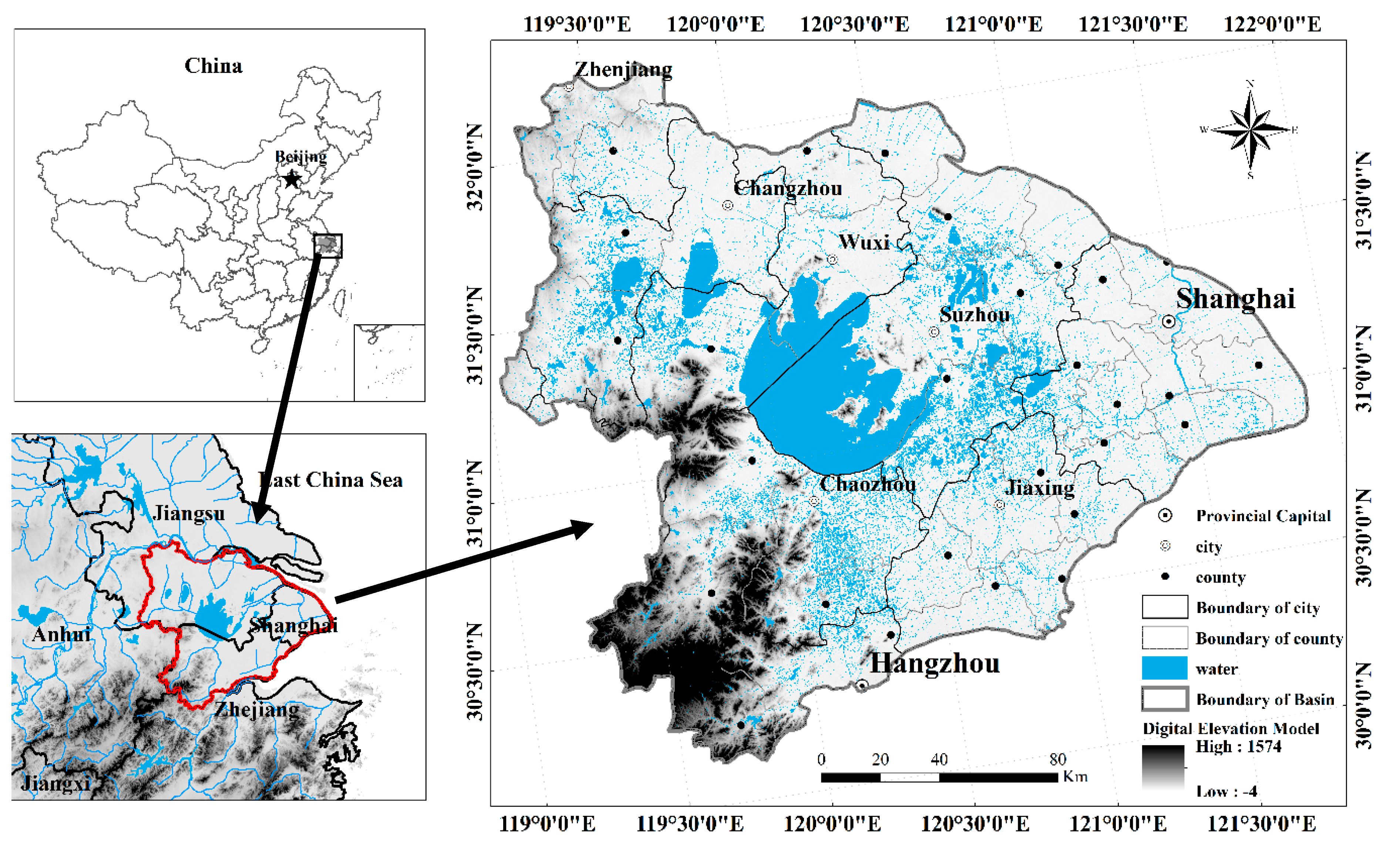
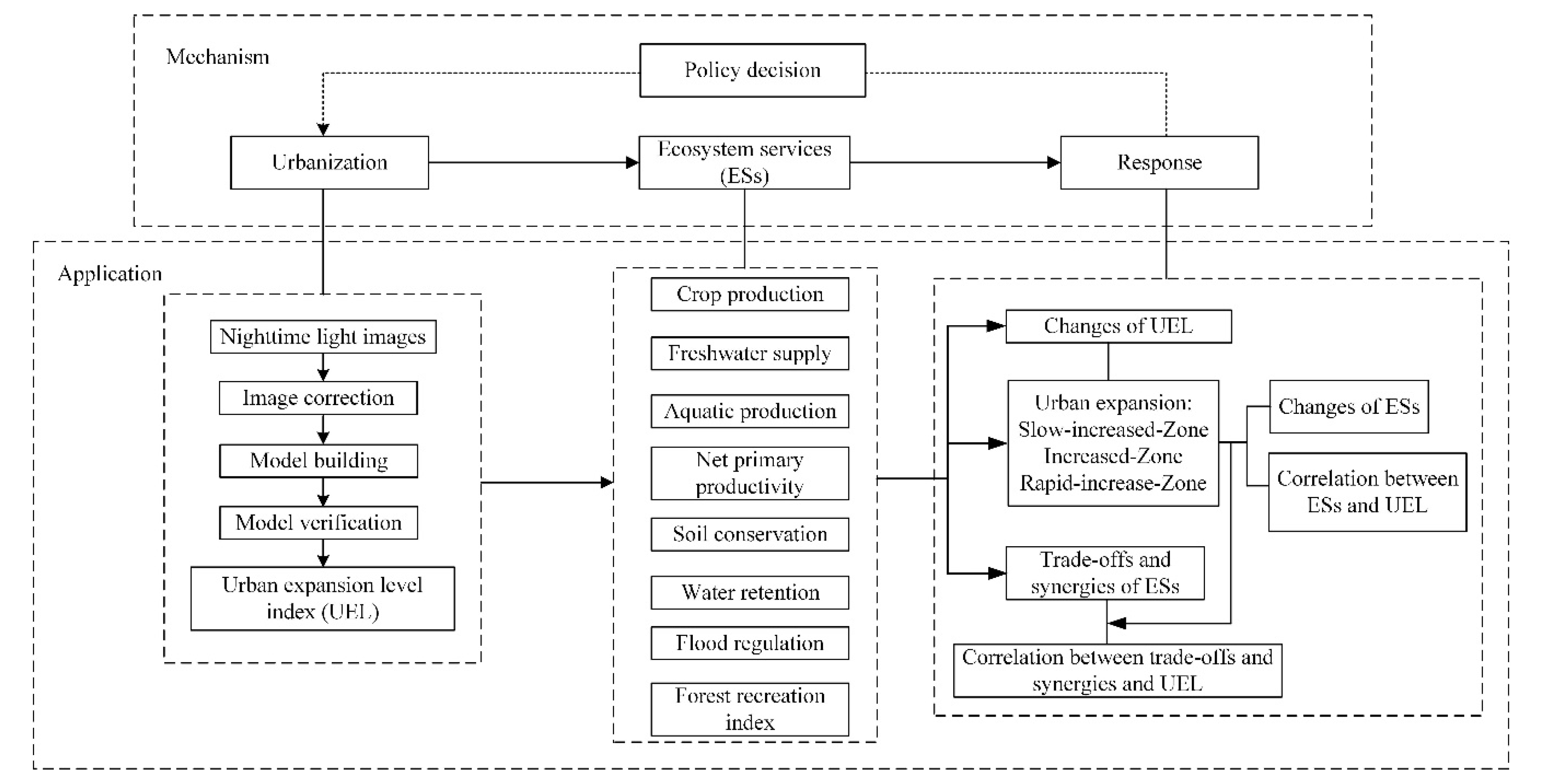


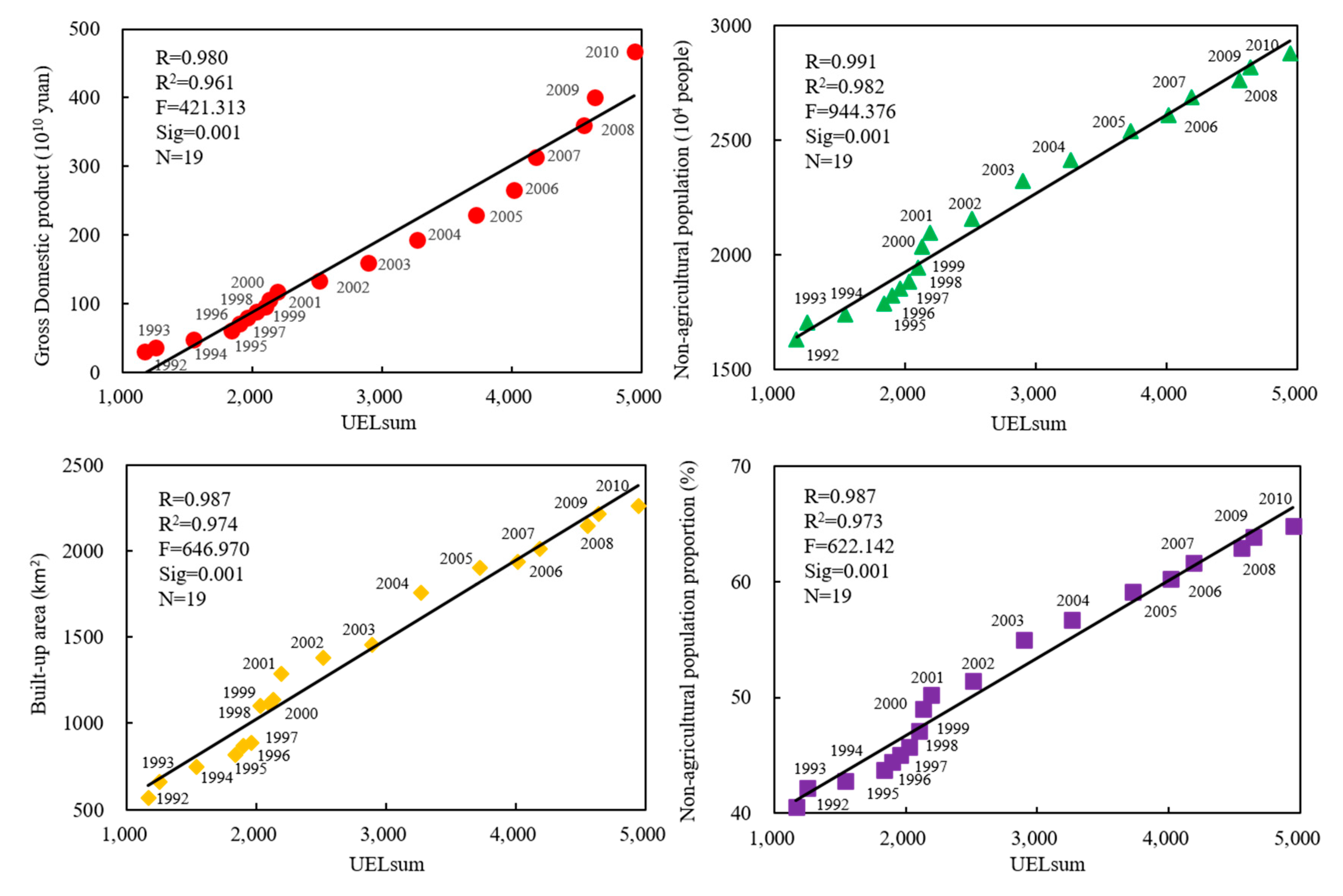

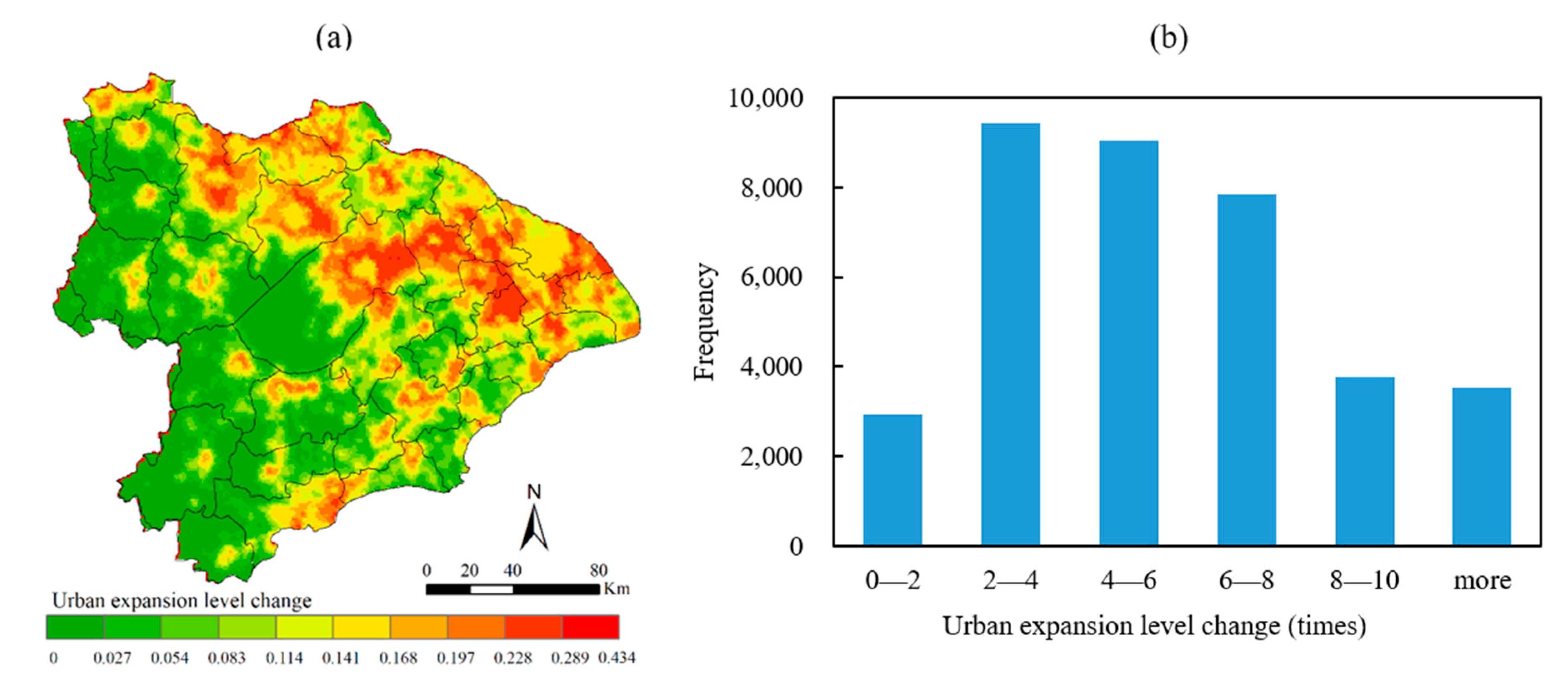
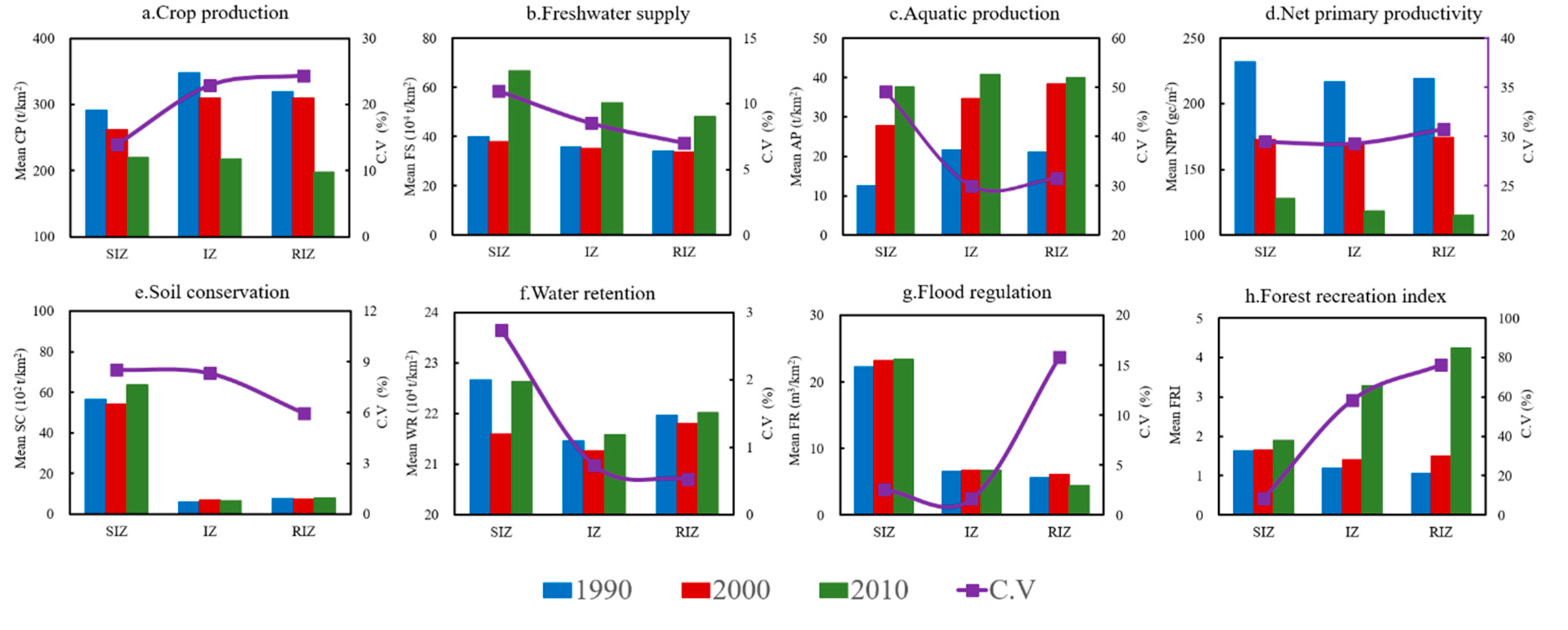
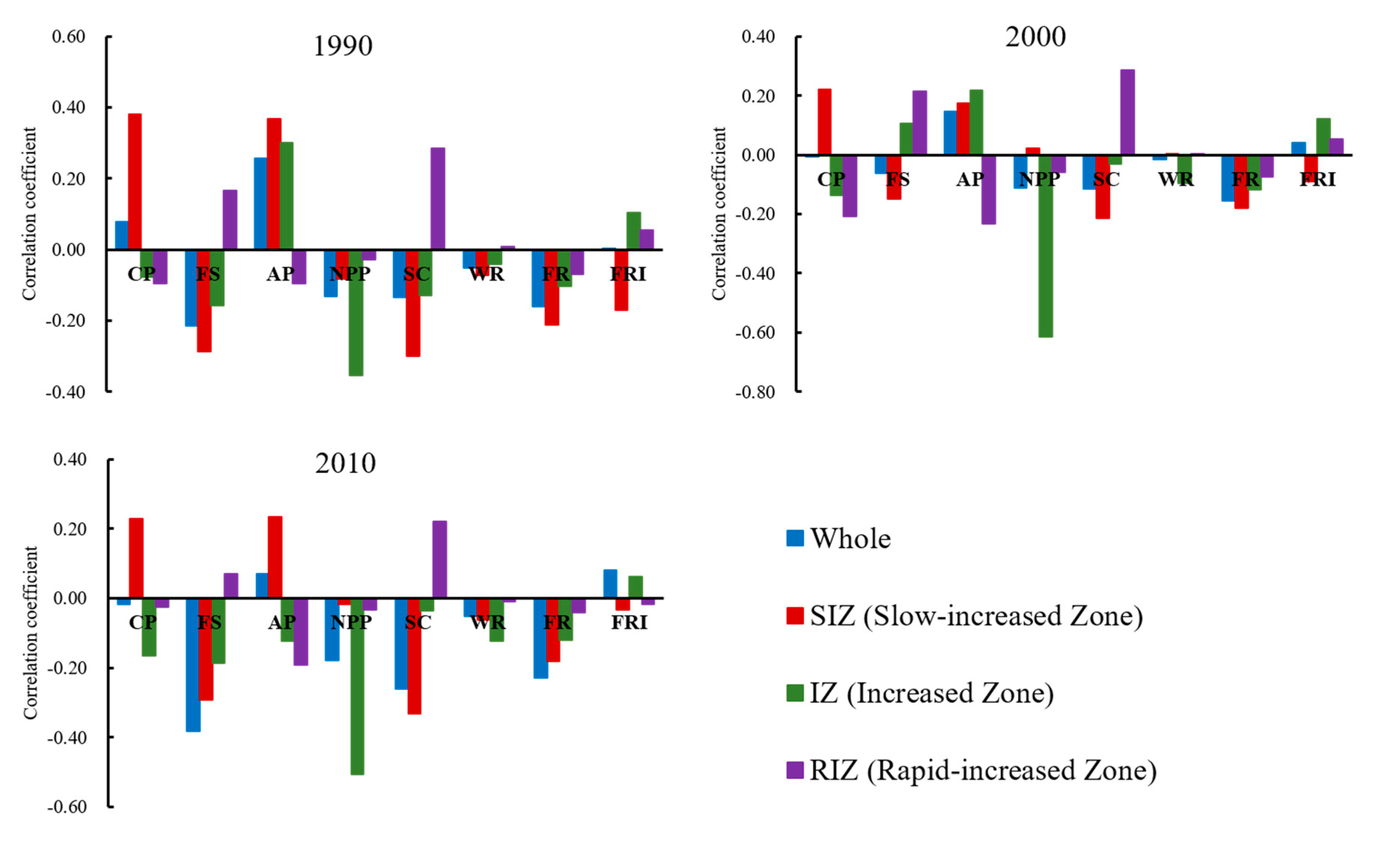
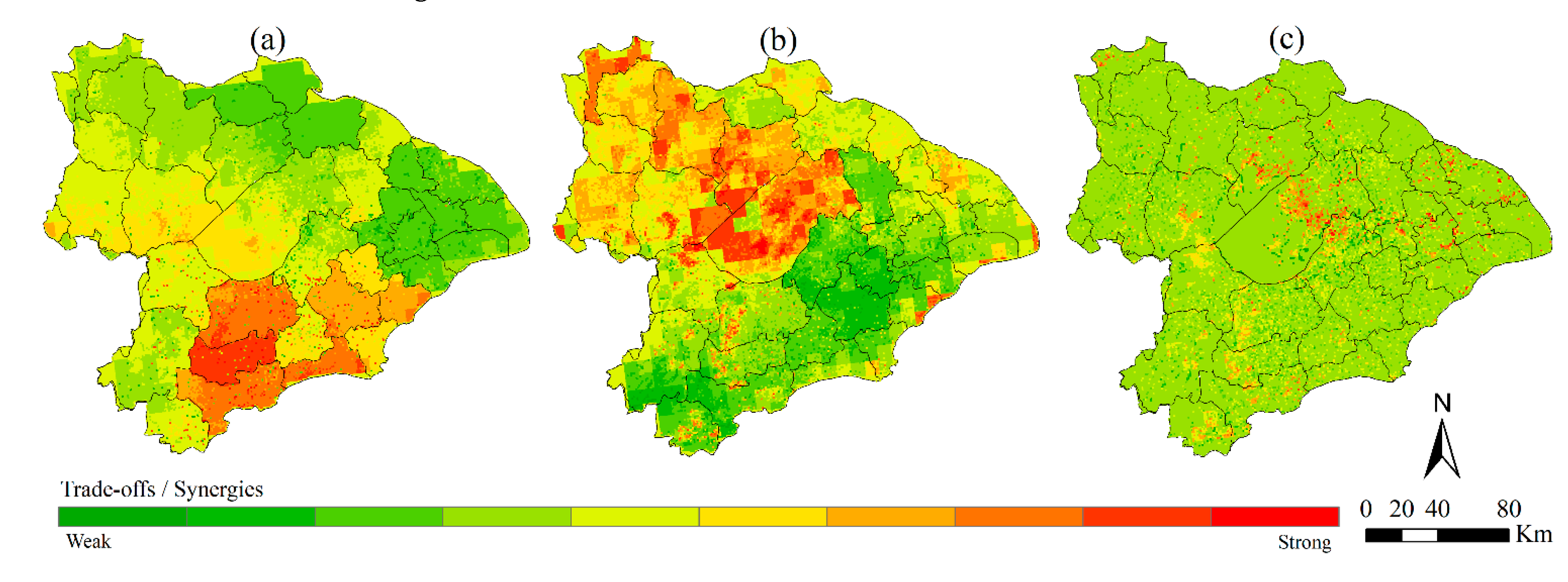
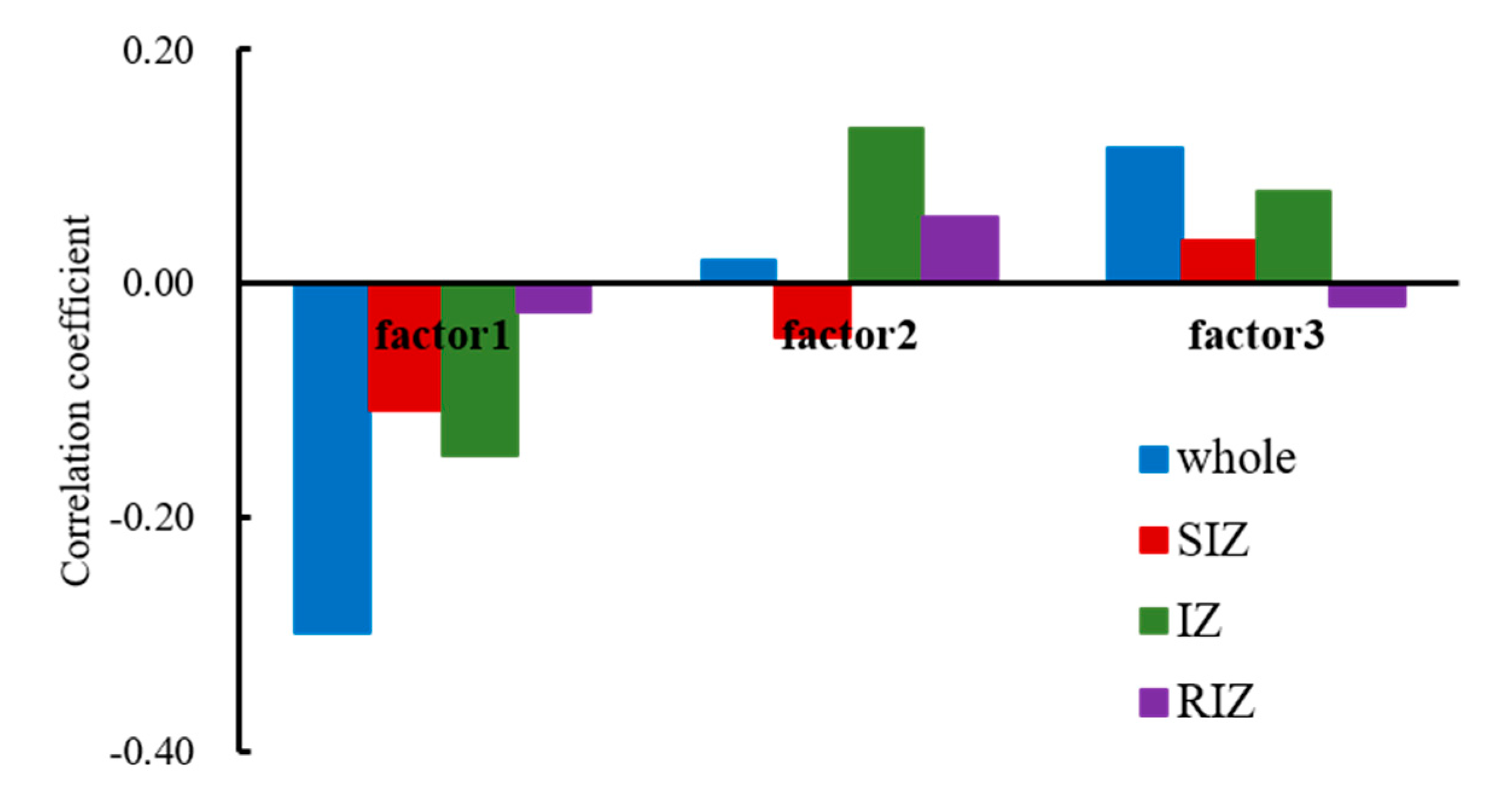
| Ecosystem services | Factor1 | Factor2 | Factor3 |
|---|---|---|---|
| Crop production | −0.077 | 0.676 | 0.011 |
| Freshwater supply | 0.663 | −0.486 | 0.011 |
| Aquatic production | 0.757 | −0.062 | −0.041 |
| Net primary productivity | 0.145 | 0.679 | 0.016 |
| Soil conservation | 0.399 | 0.225 | 0.358 |
| Water retention | −0.439 | −0.239 | 0.097 |
| Flood regulation | 0.058 | 0.084 | −0.708 |
| Forest recreation index | −0.038 | 0.053 | 0.715 |
| Variance explained (%) | 18.622 | 15.458 | 14.055 |
© 2019 by the authors. Licensee MDPI, Basel, Switzerland. This article is an open access article distributed under the terms and conditions of the Creative Commons Attribution (CC BY) license (http://creativecommons.org/licenses/by/4.0/).
Share and Cite
Gu, Y.; Qiao, X.; Xu, M.; Zou, C.; Liu, D.; Wu, D.; Wang, Y. Assessing the Impacts of Urban Expansion on Bundles of Ecosystem Services by Dmsp-Ols Nighttime Light Data. Sustainability 2019, 11, 5888. https://doi.org/10.3390/su11215888
Gu Y, Qiao X, Xu M, Zou C, Liu D, Wu D, Wang Y. Assessing the Impacts of Urban Expansion on Bundles of Ecosystem Services by Dmsp-Ols Nighttime Light Data. Sustainability. 2019; 11(21):5888. https://doi.org/10.3390/su11215888
Chicago/Turabian StyleGu, Yangyang, Xuning Qiao, Mengjia Xu, Changxin Zou, Dong Liu, Dan Wu, and Yan Wang. 2019. "Assessing the Impacts of Urban Expansion on Bundles of Ecosystem Services by Dmsp-Ols Nighttime Light Data" Sustainability 11, no. 21: 5888. https://doi.org/10.3390/su11215888





